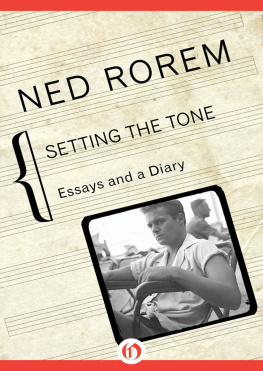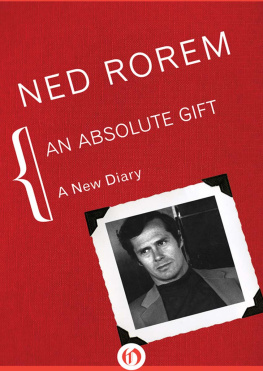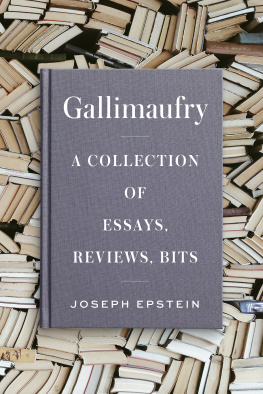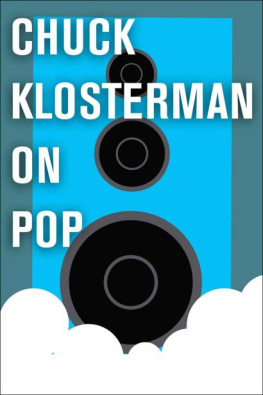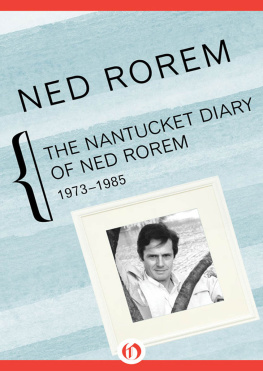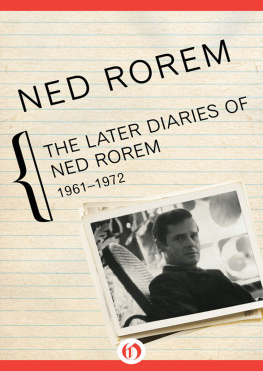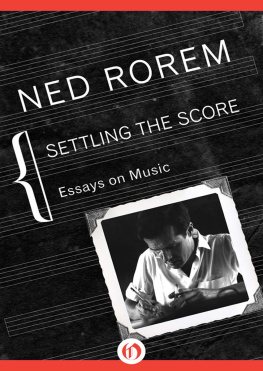
NED ROREM


SETTING THE TONE


ESSAYS AND A DIARY


To James Holmes
as to the sun.
CONTENTS
PROLOGUE
Do you still keep a diary? people sometimes ask.
Yes, insofar as a diary (as opposed to a memoir) is on-the-spot reaction to professional concerns. But no, insofar as a diary is a gossipy confessional or a platform for keening.
I began in 1945, as a release from shyness, to investigate on paper what I could not say aloud. Over the years the journal absorbed more than mere outpourings of love, vicious envy or depressions oozing from the gray corners of alcoholism; it grew into a travelogue, a recipe carnet, a social calendar with notes on works in progress. Indeed, the book became a catchall for my virtually every preoccupation except the main onemusical composition.
I was a musician who happened to write, not an author who happened to compose. Thus the diary, being random and bloody and self-indulgent, answered to different needs than the music, which was planned, pristine, objective. Or such was the case until 1966 when my first book, The Paris Diary, was published. At that time I had already been a professional composer for twenty years. Suddenly I discovered that the reading audience was far different from the listening audience, that the two did not overlap, that neumes and nouns excite separate nerves and that a composers notoriety will never equal an authors. The public ascribes less responsibility to a composer than to an author, for literature can wound where music cannot. True, when Proust lamented that the upper-crust fauna to whom he mailed galleys of Swanns Way never reacted (Madame de Chevign, the model for the Princesse de Guermantes, confessed that she caught her feet in Prousts prose), Cocteau pacified him: Do you ask ants to read Fabres studies in entomology so as to learn more about themselves? But I had written of people by name and was stunned to learn they didnt appreciate it.
Did you originally keep a diary in order for it to be read? people then ask.
Everything written is meant to be read, if only by the writer at another time. But if I were to continue to publish words, I realized that I would have to bear the consequences. Gradually, like amoebas merging and then separating, or like two Ned Rorems passing each other as they enter a mirror, my joint professions exchanged focus. If the writing today has become more planned, pristine and objective, the music, though not exactly random or bloody or self-indulgent, is, I like to think, more imbued with the kind of ugliness which is as crucial as beauty is to art. Two careers run parallel. Can I really know if they infringe upon each other, any more than general practitioners can know where the path of specialization might have led them? Most who read my words have never heard my music, while musicians are usually surprised that I have written books. Books about what?
The question is academic. Those three diaries which brought a brief though golden fame are long since out of print, as are the five collections of essays. Meanwhile musical life prevails as it did before I ever published books. Yet I still write proseas the present volume attestsbranching out now beyond my navel, with articles mainly on matters artistic commissioned by, and tailored to the requirements (sometimes even aping the tone) of, specific periodicals. And I still keep a diarythough what authors work, or indeed what composers, is not to some extent a diary? The mood is quieter. After a certain age, certain subjects become embarrassingly dull and nobodys business. One of these is sexual intercourse, another is the injustice of personal sorrow. Could the same be said of a composers palette? Will I hold to such a principle a decade from now? These paragraphs, in guise of a preface, are themselves as inconclusive as diary entries.
The diarist years later cannot be sure if he is recalling an actual occurrence, or what he wrote about the occurrence. The composer endures no such confusion: he never knows, in vision or in verbs, what hes composing about.
Bon mots in writing, like percussion in music, are effective in inverse proportion to their frequency. Thus I cant condone, on technical grounds, certain repetitions within the overall text. (While correcting the galleys, for example, I found three statements of Critics of words use words; critics of music use words.) If I did not remove some of these repetitions it was partly because in different contexts they took on different emphasesor so I prayedand partly because redundant obsession is the woof of the diaristic mode.
Most of the pieces in this book have appeared elsewhere during the past two or three years, generally in a different shape.
The Piano in My Life is from a volume of miscellaneous essays called The Lives of the Piano. Being Alone was first published in The Ontario Review, Paris in the Spring in Antaeus and Nantucket Diary, 1974 in Tri Quarterly.
Since 1979 I have contributed regularly to Christopher Street, and the following articles were first printed therein: Of Vanity, Setting the Tone, When Paul Jacobs Plays Debussy, Thinking of Ben, Boulez and More Notes on Song.
Other articles were commissioned as book reviews: On Edmund Whites States of Desire, Misia, Vera Stravinskys and Robert Crafts Stravinsky in Pictures and Documents were in The Washington Post Book World, and so was Being Ready. Cosima Wagners Diaries, Shostakovich, An Auden, Courageous Coward and Shaw were in Chicago Tribune Book World. Boulanger as Teacher was in The New York Times Book Review.
Still others came out first as record reviews or as liner notes. Faurs Songs was in Stereo Review, while Faur and Debussy and The American Art Song graced disc jackets for, respectively, Columbia Records and New World Records.
Five pieces were originally conceived as lectures: Women in Music was delivered at a feminist symposium organized by Francine du Plessix Gray at Rutgers and later was published in Vogue. Thirteen Ways of Looking at a Critic was for a critics panel in Santa Fe. Teaching and Performance was a commencement address at the Curtis Institute, refashioned from a similar address at Northwestern five years earlier.
Messiaen and Carter on Their Birthdays was broadcast as an homage on the BBC in London, then published in The Spectator, while Stravinsky at 100 was spoken before the Chamber Music Society of Lincoln Center, then published in Opera News.
Opera News also published The Mlisande Notebook, A Triptych Notebook and Considering Carmen.
Cocteau and Music, commissioned by the French-American Foundation for an upcoming retrospective, first appeared in

